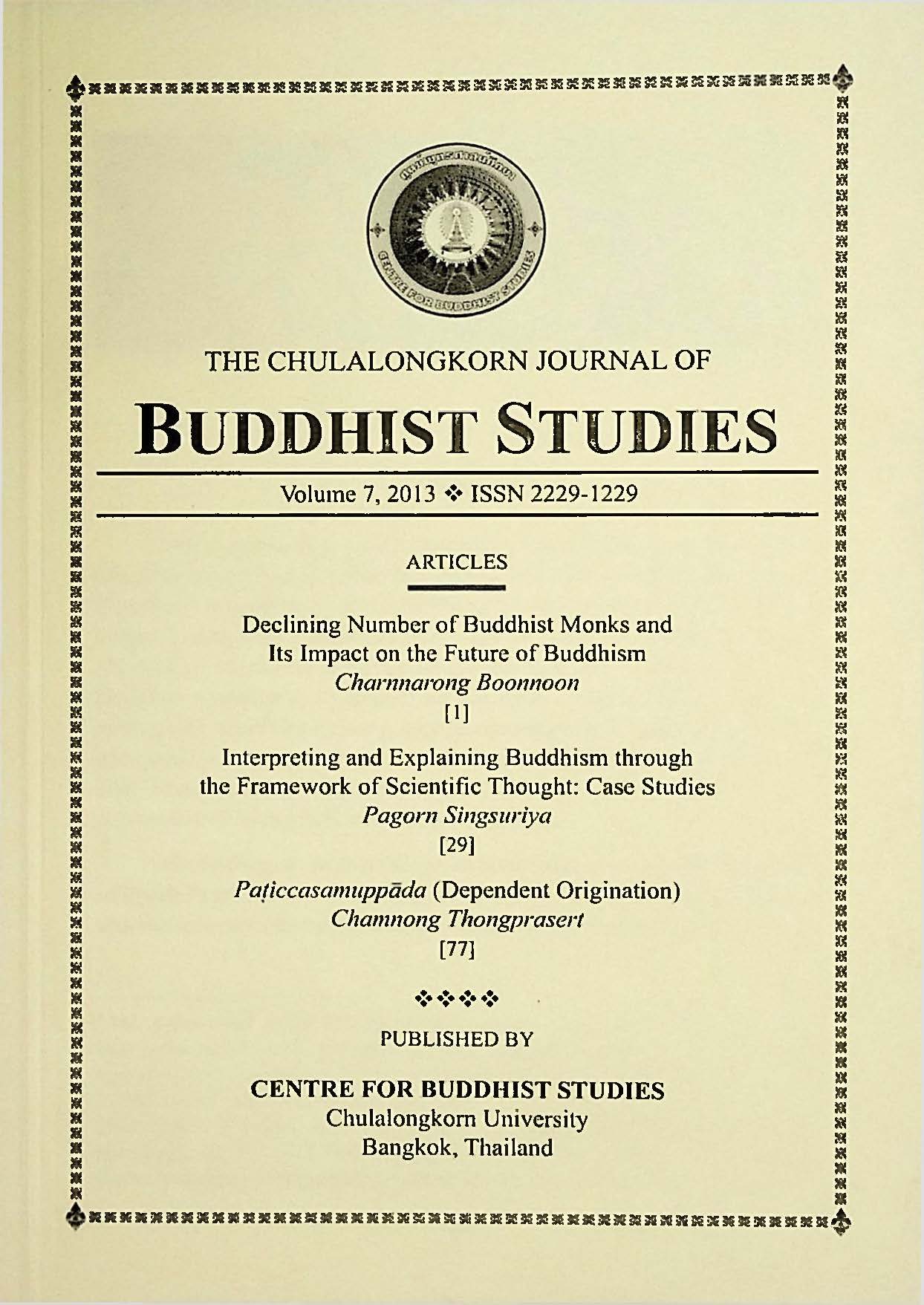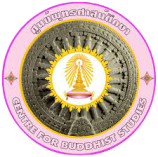Interpreting and Explaining Buddhism through the Framework of Scientific Thought: Case Studies
Abstract
This study aims to a) understand the hermeneutics of Buddhism within scientific frameworks; b) evaluate the interpretations and explanations of Buddhism using scientific frameworks; and c) recommend appropriate approaches to the interpretation and explanation of Buddhism through scientific frameworks by considering case studies in Thailand. Study results have shown that a) the models found in various case studies comprise a “reactionary hermeneutics” and a “hermeneutics of corporality”; b) that fallacies and scientific misunderstandings are used in the development of hermeneutics; and c) that appropriate approaches to the interpretation and explanation of Buddhism using science should be developed in a mutually supportive framework.
References
Khamphirayan Aphipunyo, Phra. (2008). Science and Buddhism. Bangkok: Institute for the Spread of Dhamma.
Chaiyaphruek Phenwichit. (1996). Buddhism and Science. Bangkok: Dokya Press.
Chaiyaphruek Phenwichit. (1999). Universal Science 2. Bangkok: Chulalongkorn University Press.
Thammakosachan (Prayun Thammachitto), Phra. (2009a). Ways of Integrating Buddhism and Modern Science. Phra Nakhon Si Ayutthaya: Mahachulalongkomrajavidyalaya.
Thammakosachan (Prayun Thammachitto), Phra. (2009b). Dhamma Lecture in Honor of His Majesty the King on Buddhism and Science, Fostering a Culture of Insight. Sarot Siwamoktham (Editor), Buddhism and Science, Fostering Cultural Insight to Commemorate His Majesty the King Bhumibol Adulyadej’s 82nd Birthday, 5 December 2009. Page 37-63. Bangkok: Pitak Press.
P.A. Payutto (2000). Dictionary of Buddhism, Compiled Edition. 9th printing. Bangkok: Mahachulalongkomrajavidyalaya Press.
Bancha Thanabusombat. (2008). Distorted Science: Einstein Meets the Buddha [Online]. Accessed 15 July 2011 at http://www.gotoknow.org/blog/science/192799
Bancha Thanabusombat. (2009). What does the “Uncertainty Principle ” in Quantum Mean? [Online]. Accessed 15 July 2011 at http://www.gotoknow.org/blogs/posts/315496
Phawananusat, Phra Khru (Thammatharo Bhikkhu). (no year of print). Recommendations for Practicing the Four Postures. Suphanburi: Wat Sai-ngam Meditation Center.
Meltanantho Bhikkhu, Phra. (2002a). Incidents that Occurred in Year 1 B.E., Volume I: Analysis of the Buddha’s Parinibbana. Bangkok: Phra Athit Press.
Meltanantho Bhikkhu, Phra. (2002b). Incidents that Occurred in Year I B.E., Volume 2: Analysis of the First Rehearsal of the Scriptures and the Bhikkhuni Sangha. Bangkok: Phra Athi Press.
Royal Institute of Thailand. (1999). The Royal Institute Dictionary of World Religions. Bangkok: Author.
Rotung Suwansutthi. (2009). Dialogue in Honor of His Majesty the King on “Buddhism and Science, Fostering a Culture of Insight”. Sarot Siwamoksatham (Editor), Buddhism and Science, Fostering Cultural Insight to Commemorate His Majesty the King Bhumibol Adulyadejs 82nd Birthday Anniversary, 5 December 2009. pp 97-99. Bangkok: Phitak Press.
Watchara Ngamchitcharoen. (2011). Buddhism and Modem Physics. Journal of Buddhist Studies Chulalongkorn University 18 (1), 39-65.
Supphawan Phiphatphanwong Krin. (2007). Einstein Asks, the Buddha Answers: From Cosmic Questions to Timeless Answers. Bangkok: Free Mind.
Som Suchira. (2010). Einstein Discovers, the Buddha Sees. Bangkok: Amarin Printing and Publishing.
Saengthian Yuthao. (2009). Buddhist Statistics: Conceptual Ways of Joining Statistics and Buddhism. Sahasat 9 (3), 13-38.
Atthanit Phokhasap. (2009). Great Magical Incantation in Thai Boxing. Bangkok: P. Wathin Publication Ltd.
Amnuai Khamprang. (2000). Science and Buddhism. Bangkok: Chamchuri Products.
Olan Phiantham. (2006). In Search of Truth: Science and Buddhadhamma. Bangkok: Thammada Press.
Cabezon, J.I. (2003). Buddhism and Science: On the Nature of the Dialogue. B. Alan Wallace (Ed.) in Buddhism and Science: Breaking New Ground. Columbia University Press.
Collett, A. (2009). Historio-Critical Hermeneutics in the Study of Women in Early Indian Buddhism. Nurnen 56, 91-117.
Dalai Lama, His Holiness the XIV. (2003). Understanding and Transforming the Mind. In B. Allan Wallace (Ed.). Buddhism and Science: Breaking New Ground. 91-103. Columbia University Press.
Explication & Interpretation. (1998). Critical Link. University of Hawai'i. [Online]. Retrieved October 2,2011 from http://www.english.Hawaii,edu/criticalink/explication/index.html.
Jones, A.Z. & Robbins, D. (n.d.). Eisteins Special Relativity. [Online], Retrieved on December 2, 2011 from http://www.dummies.com/how-to/content/einsteins-special-relativity.html.
Lopez, D.S. (2008). Buddhism & Science. A Guide for the Perplexed. Chicago: The University of Chicago Press.
McMahan, D.L. (2004). Modernity and the Early Discourse of Scientific Buddhism. Journal of the American Academy of Religion 72 (4), 897-933.
Mishlove, J. (1997). The Roots of Consciousness: The Classic Encyclopedia of Consciousness Studies. Revised and Expanded Edition. New York: Marlowe & Co.
Powers, J.R. (1982). Philosophy and the New Physics. London: Routledge.
Restivo, S.P. (1978). Parallels and Paradoxes in Modern Physics and Eastern Mysticism: I - A Critical Reconnaissance. Social Studies of Science 8 (2), 143-181.
Ricoeur, P. (1981). The Model of the Text: Meaningful Action Considered as a Text. In John B. Thompson (Ed. and Trans.), Hermeneutics and the Human Sciences: Essays on Language, Action, and Interpretation. 197-221. Cambridge: Cambridge University Press.
Wallace, B.A. (2003). Introduction. In Author (Ed.), Buddhism and Science: Breaking New Ground. Columbia University Press.
Welch, C. (2003). Historical Criticism. In J. Wentzel Vrede van Huysstcen (Ed.). Encyclopedia of Science and Religion. Vol. 7, pp. 410-412. New York: Macmillan Reference.
York, M. (2004). Historical Dictionary of New Age Movements. Lanham, MD: Scarecrow Press.







